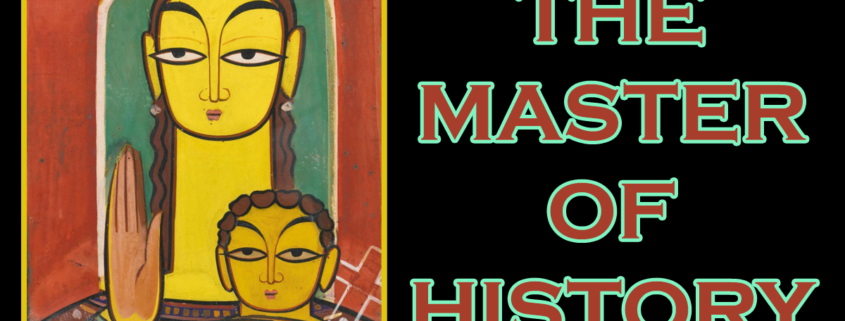The Master of History
The scriptures say that Christ is the Alpha and Omega, the beginning and the end (Revelation 22:13). It would be extremely helpful, knowing that most of us are familiar with the theological implication of this claim, to know how Christ lives out this statement in history. To do this we will briefly look at the developments in early twentieth-century India, a place where western historians and anthropologists study the least with regards to Christ’s impact on history.
But it is not enough to just observe the anthropology or the “facts” as many are in the habit of doing. By merely looking at the historical trajectory, along with the causes and correlation, we would equate ourselves to a gleeful murder-mystery reader eager to know whodunnit. If by our observation we are not able to draw moral lessons that would enable us to love our neighbors as Christ would have us then our study would be an exercise in vanity.
When we study the influence of Christ on India, our instinctive reaction would be to go to the colonial missionaries. The impression we would get out of that approach is that the British empire succeeded in shaping India into a nation fit to receive British goods and ideas via unjust trading practices, social degradation, and monopoly capitalism. This impression, although incomplete, would nevertheless be right.
The missionaries who came to India with the intention of preaching Christianity ended up preaching a westernized form of Christianity that aimed to create a middle-class which would serve as intelligentsia for the Empire. This had far-reaching consequences, much further than the British themselves came to realize, for the western-educated intelligentsia of India would adopt western ideas such as nationalism and self-autonomy which would give rise to the Swadeshi (self-ownership) movement with Mohandas Gandhi as the spearhead.
Gandhi’s movement was a peculiar phenomenon in world history. Never before had anyone seen a movement led in the principle of non-violence against a heavily industrialized, aggressive, and determined opposition. This movement would influence Dr. Martin Luther King in his fight for civil rights in America during the sixties. Where did Gandhi get this idea of “non-violent resistance?” Gandhi himself has ascribed it to the principle of ahimsa–the idea of universal non-violence in Hinduism, Jainism, and Buddhism.
But ahimsa, in Indian history, was never a political phenomenon. Why did it become one and what caused it to be so? Gandhi also lists as his influence Leo Tolstoy’s book The Kingdom of God Is Within You which he claims to have “left an abiding impression” on him.1 In his book, Tolstoy maps out what would later come to be known as “Christian anarchism.” He writes:
A man of the present day, whether he believes in the divinity of Christ or not, cannot fail to see that to assist in the capacity of tzar, minister, governor, or commissioner in taking from a poor family its last cow for taxes to be spent on cannons, or on the pay and pensions of idle officials, who live in luxury and are worse than useless; or in putting into prison some man we have ourselves corrupted, and throwing his family on the streets; or in plundering and butchering in war; or in inculcating savage and idolatrous superstitious in the place of the law of Christ; or in impounding the cow found on one’s land, though it belongs to a man who has no land; or to cheat the workman in a factory, by imposing fines for accidentally spoiled articles; or making a poor man pay double the value for anything simply because he is in the direst poverty;–not a man of the present day can fail to know that all these actions are base and disgraceful, and that they need not do them. They all know it.2
And,
… the Christian, who is subject only to the inner divine law, not only cannot carry out the enactments of the external law, when they are not in agreement with the divine law of love which he acknowledges (as is usually the case with state obligations), he cannot even recognize the duty of obedience to anyone or anything whatever, he cannot recognize the duty of what is called allegiance.3
In these passages, we see Jesus’ impact on the political and economic world mapped out in living colors. We see the story of Jesus brought out from the individual sphere to the societal sphere; in short, we see Jesus’ teachings applied in a holistic manner. And in this application of Jesus’ political teachings, we see a strange yet obvious phenomenon.
When Gandhi’s nonviolent movement was in full flow, American Methodist missionary E. Stanley Jones recalls the many moments which stood out for him.
He writes:
In one of the important [nationalist] conferences… a Hindu nationalist said, “I oppose this non-violent non-cooperation. I ask you is it Hindu teaching? It is not. Is it Mohammedan teaching? It is not. I will tell you what it is, it is Christian teaching. I therefore oppose it.”4
And,
In a Nationalist paper at the time of great national excitement there appeared this flaming headline, “A Dreadful Night of Crucifixion.” I read through the account with eagerness to see what had happened. It was a vivid account of how Akali Sikhs, resisters, were severely beaten by the police. It ended with this sentence: “Gentle reader, on that dreadful night Christ was again crucified.” This was written by a Hindu for Hindus and Mohammedans, but they had caught the idea that Christ was identified in some mysterious way with the pain and suffering and oppression of men.5
Jones also recalls some peculiar statements made to him by Indian nationalists.
A nationalist put the matter to me this way: “It is you Christians who can understand the inner meaning of our movement better than others, for it has a kinship to the underlying thought of Christianity.” The man who said this was a man of beautiful character and was acting upon that inner meaning. One nationalist asked me, “Do you not think that the Non-Cooperation movement is an application of the principles of Jesus to the present political situation?”6
Jones continues telling the story of Christ being manifested through irregular channels. He speaks of an event that moved him deeply.
In one place the nationalists were forbidden by the government to carry the national flag beyond a certain point on a bridge which led into the European or Civil section of the town. The nationalists made it an issue. The magistrate, who arrested and tried most of them, remarked to me that those whom he arrested were much more Christian in their spirit than he was. They would let him know what time they were coming across the bridge with the flag and how many! Would he please be prepared for twenty-five today. Of the twelve hundred who were arrested in that flag agitation, although none of them were professed Christians, and although they could take into jail with them only a limited number of things which they had to produce before the magistrate, the vast majority took New Testaments with them to read while there. The reason they did so becomes apparent when one of them remarked, “We now know what it means for you Christians to suffer for Christ.” The cross had become not a doctrine, but a living thing to them.7
Jones summarizes these experiences with the following:
As for satisfying a racial superiority complex and being the forerunners of imperialism and capitalism, let us say that Jesus is the one Figure that stands blocking every road of political and economic exploitation in the East. He is troubling exploiters everywhere. He has got hold of them. They cannot grab and exploit with quite so easy a conscience as they once did. Moreover, amid the racial clashes and bitterness there stands one who is the Son of man. Racialism withers under his real touch. He is the Friend of Men.8
Here, one may hear the skeptic cite the many flaws in Gandhi’s character as an attempt to disprove the Christian influence on the Indian nationalist movement and to do that one has to assume that all the above passages have been provided as a defense of Gandhi’s character. What we have observed here is very clearly a historical person being made manifest through a very particular political phenomenon.
Neither Gandhi nor Tolstoy professed any kind of faith in the exclusive divinity of Christ yet the fruits of their work led people to draw some obvious comparisons. What does this say of the million-strong churches of the West? What does this say of Christ’s witness as practiced by “Christian” governments? Most importantly, what does this say about the manner in which Christ acts in human cultures?
It is hard to find a non-Christian culture equating Jesus to political doctrines such as Capitalism, Socialism, Marxism, or Anarchism. If a culture has managed to somehow equate Jesus to any of these things it is because the idea has been drilled into it by an external force. The one thing that is inescapable whenever anybody thinks about Christ is the cross of Calvary. The cross of Christ has an alluring mystery behind it. This is why the apostle Paul wrote the following:
For I resolved to know nothing while I was with you except Jesus Christ and him crucified.
–1 Corinthians 2:2 (New International Version)
How do we manifest the power of Christ in today’s world? E. Stanley Jones’ reports of what went on in early twentieth-century India should give us all some valuable clues. The cross of Christ must take the center stage again.
1. M.K. Gandhi, The Story of My Experiments with Truth
2. Leo Tolstoy, The Kingdom of God Is Within You
3. Ibid.
4. E. Stanley Jones, Christ of the Indian Road
5. Ibid.
6. Ibid.
7. Ibid.
8. Ibid.












Leave a Reply
Want to join the discussion?Feel free to contribute!